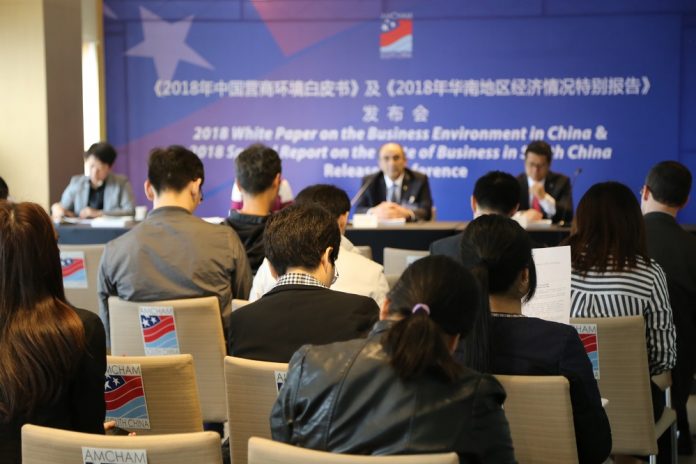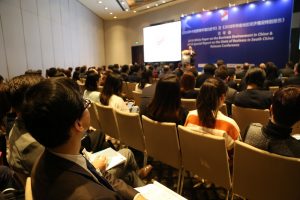
华南美国商会(下简称“美商会”)向外界发布其《2018年中国营商环境白皮书》(下简称《白皮书》)及《2018年华南地区经济情况特别报告》(下简称《特别报告》)。 The American Chamber of Commerce in South China (“AmCham South China”) released its 2018 White Paper on the Business Environment in China and 2018 Special Report on the State of Business in South China. 总计533页的《白皮书》是美商会第十年的年度报告,它通过详尽的研究与引证,对中国真实的营商环境进行了一次全面的调查;同时,《特别报告》整合并分析了244家今年参加经济情况问卷调查的受访企业的反馈结果。 The 533-page 2018 White Paper, now in its tenth year, presents a highly researched, exhaustively cited account of the on-the-ground business environment in China. The 2018 Special Report, meanwhile, aggregates and analyzes the experiences of 244 companies who participated in the Chamber’s annual Study of State of Business. “今年我们从调查中得出的好消息是,随着中央及地方政府发出将进一步开放市场、欢迎更多外国投资的信号,外资企业更为乐观。” 华南美国商会会长哈利·赛亚丁博士在发布会上指出,“中国国家主席习近平在中共第十九次全国代表大会开幕式的致辞中提出,中国政府将对在中国境内注册的所有企业平等对待、一视同仁。我们赞同这一指导思想,并期待一个能够实现共同获益的公平竞争环境。” 《白皮书》显示,迄今为止,广东省政府反应最为迅速,在2017年12月已发布《广东省进一步扩大对外开放积极利用外资若干政策措施》(通常称为《外资十条》)。广东省政府对外国投资表现出更为开放的态度,尤其是在吸引高层次人才方面。 “The good news is that foreign companies are cautiously more optimistic as the central and local governments are giving signals that they will open up the market and welcome more foreign investment,” said AmCham South China President Dr. Harley Seyedin. “During the 19th National Congress of the Communist Party of China, Chinese President Xi Jinping said that all businesses registered in China will be treated equally. We applaud President Xi’s words and thoughts as we look forward to a more level playing field where we can all profit together.” The 2018 White Paper shows that so far, Guangdong government is the most responsive with the December 2017 release of “Policies and Measures of Guangdong Province on Further Expanding Opening-up and Actively Attracting Foreign Direct Investment (FDI)”, commonly known as Ten Measures for Attracting FDI. Guangdong government is showing a more open approach toward foreign investment, particularly in attracting high-level talents. 《白皮书》讨论的话题众多,其中包括外资企业对中国经济产生的影响。例如,外资企业分别为中国国内生产总值(GDP)及就业率贡献了约33%及27%。美资企业及其对中国经济的连锁反应每年对中国GDP的贡献是美国外国直接投资流量的180倍,也是美资企业年净利润的11倍。 Among many topics, the 2018 White Paper discusses the impact of foreign-invested enterprises on China’s economy. For example, foreign companies help generate one-third of China’s GDP and over one-quarter of its employment. U.S. companies and their ripple effects through China’s economy contribute more than 180 times the value of the usual measure of USFDI inflow, and 11 times the net profit of U.S. firms, to China’s GDP each year. 《特别报告》显示,中国仍受国际投资者欢迎,究其原因是其在全球市场中的增长潜力。对于大多数受访企业(53.3%)而言,中国在其全球投资计划中位居榜首;近90%受访企业已达盈利,剩余受访企业则有望在未来两年内盈利;近70%受访企业认为他们2017年在华投资的回报率比其他地区更高。 The 2018 Special Report demonstrates that China remains popular for international investment due to its potential for global market growth. For most of the respondents (53.3 percent), China accounted for the top spot in their global investment plans. Roughly 90 percent of participants reported being profitable already with most of the remaining companies expecting profitability within two years or less. Meanwhile, nearly 70 percent believed their overall return on investment in China in 2017 was better than elsewhere.  今年的报告显示,广州在中国44个城市投资排名中脱颖而出成为最受欢迎的投资城市,其后为深圳、上海和北京。广州和深圳通过努力首登榜首及榜眼。然而,在调查地区中也有一些城市却因专注于收回属于外企使用的工业用地而跌至榜尾。这些城市有意从房地产开发中“赚快钱”,而非放远目光,保留这些外企及引进其最新研发的技术。 This year, Guangzhou ranked as the most popular investment city within a list of 44 cities in China, followed by Shenzhen, Shanghai, and finally Beijing. Guangzhou and Shenzhen have worked hard to achieve the coveted top spots in our Special Report for the first time. A couple of other cities located in the area, however, have sunk to the bottom of the list because they are focused on taking land that rightfully belongs to foreign-invested enterprises. These cities are attempting to make quick profits from real estate development rather than focusing on the future by keeping those enterprises and their newly developed technologies. 与此同时,73.3%的受访企业反映其业务重心为在华为本地市场生产商品及提供服务,只有26.7%以出口商品为主。约83%的受访企业认为华南地区营商环境“好”或“非常好”,同比上升6%,其中多数认为此地营商环境在过去一年中显著提升。 Meanwhile, 73.3 percent of participants reported that their primary business focus was providing goods or services to the Chinese market, while only 26.7 percent reported a primary focus of manufacturing for export. About 83 percent of participants ranked the business environment in South China as “good” to “very good”, an improvement of 6 percent, and most participants felt the business environment had improved over the past 12 months. 调查显示,受访企业2018年在华再投资预算也受其上涨的积极情绪影响,同比上升近12%。预计美商会会员企业2018年在华再投资预算将达到140亿美元,意在扩大在华运营、提高新市场份额。值得注意的是,受访企业在2017年将其在华南地区的再投资转移到其他市场的比例同比下降约四分之一。 The increased optimism seems to have also affected reinvestment budgets. The report shows that the budgeted reinvestment from corporate profits in China by members of AmCham South China is expected to rise by nearly 12 percent with an estimated reinvestment budget of US$14 billion to expand existing operations and to capture new and larger market shares. Also, the number of those who transferred their South China reinvestments to other markets in 2017 decreased by approximately one-fourth year-on-year. 虽然大多受访企业认为华南地区前三大运营挑战为“人力资源成本增加”、“缺乏合格的人才”及“本地竞争激烈”,而最大的法规难题包括“税法”、“政府采购政策”、“网络安全政策”、“海关合规”及“标准、证书和合格评定”,但有兴趣在华南地区自贸区建立新办公室或业务点的受访企业比例仍显著提高,其中超55.2%偏向广东南沙自贸区,深圳前海自贸区及珠海横琴自贸区紧随其后。 Most companies surveyed claimed the top three business challenges in South China were “increasing human resource costs”, “shortage of qualified talent”, and “fierce local competition” – and that the biggest regulatory challenges included “tax policy”, “government procurement policy”, “cybersecurity regulations”, “customs compliance”, and “standards, certification, and conformity assessment” – there was a remarkable increase in the number of respondents interested in setting up new offices or facilities in the free trade zones in Southern China, of which more than 55.2 percent indicated their preference in Guangdong Nansha Free Trade Zone, followed by its counterparts in Qianhai, and Hengqin.
今年的报告显示,广州在中国44个城市投资排名中脱颖而出成为最受欢迎的投资城市,其后为深圳、上海和北京。广州和深圳通过努力首登榜首及榜眼。然而,在调查地区中也有一些城市却因专注于收回属于外企使用的工业用地而跌至榜尾。这些城市有意从房地产开发中“赚快钱”,而非放远目光,保留这些外企及引进其最新研发的技术。 This year, Guangzhou ranked as the most popular investment city within a list of 44 cities in China, followed by Shenzhen, Shanghai, and finally Beijing. Guangzhou and Shenzhen have worked hard to achieve the coveted top spots in our Special Report for the first time. A couple of other cities located in the area, however, have sunk to the bottom of the list because they are focused on taking land that rightfully belongs to foreign-invested enterprises. These cities are attempting to make quick profits from real estate development rather than focusing on the future by keeping those enterprises and their newly developed technologies. 与此同时,73.3%的受访企业反映其业务重心为在华为本地市场生产商品及提供服务,只有26.7%以出口商品为主。约83%的受访企业认为华南地区营商环境“好”或“非常好”,同比上升6%,其中多数认为此地营商环境在过去一年中显著提升。 Meanwhile, 73.3 percent of participants reported that their primary business focus was providing goods or services to the Chinese market, while only 26.7 percent reported a primary focus of manufacturing for export. About 83 percent of participants ranked the business environment in South China as “good” to “very good”, an improvement of 6 percent, and most participants felt the business environment had improved over the past 12 months. 调查显示,受访企业2018年在华再投资预算也受其上涨的积极情绪影响,同比上升近12%。预计美商会会员企业2018年在华再投资预算将达到140亿美元,意在扩大在华运营、提高新市场份额。值得注意的是,受访企业在2017年将其在华南地区的再投资转移到其他市场的比例同比下降约四分之一。 The increased optimism seems to have also affected reinvestment budgets. The report shows that the budgeted reinvestment from corporate profits in China by members of AmCham South China is expected to rise by nearly 12 percent with an estimated reinvestment budget of US$14 billion to expand existing operations and to capture new and larger market shares. Also, the number of those who transferred their South China reinvestments to other markets in 2017 decreased by approximately one-fourth year-on-year. 虽然大多受访企业认为华南地区前三大运营挑战为“人力资源成本增加”、“缺乏合格的人才”及“本地竞争激烈”,而最大的法规难题包括“税法”、“政府采购政策”、“网络安全政策”、“海关合规”及“标准、证书和合格评定”,但有兴趣在华南地区自贸区建立新办公室或业务点的受访企业比例仍显著提高,其中超55.2%偏向广东南沙自贸区,深圳前海自贸区及珠海横琴自贸区紧随其后。 Most companies surveyed claimed the top three business challenges in South China were “increasing human resource costs”, “shortage of qualified talent”, and “fierce local competition” – and that the biggest regulatory challenges included “tax policy”, “government procurement policy”, “cybersecurity regulations”, “customs compliance”, and “standards, certification, and conformity assessment” – there was a remarkable increase in the number of respondents interested in setting up new offices or facilities in the free trade zones in Southern China, of which more than 55.2 percent indicated their preference in Guangdong Nansha Free Trade Zone, followed by its counterparts in Qianhai, and Hengqin.  《白皮书》及《特别报告》可在美商会官网免费下载:www.amcham-southchina.org or 扫描二维码下载。 Both documents may be downloaded free of charge from the Chamber’s website at www.amcham-southchina.org or by scaning the QR code.
《白皮书》及《特别报告》可在美商会官网免费下载:www.amcham-southchina.org or 扫描二维码下载。 Both documents may be downloaded free of charge from the Chamber’s website at www.amcham-southchina.org or by scaning the QR code.





